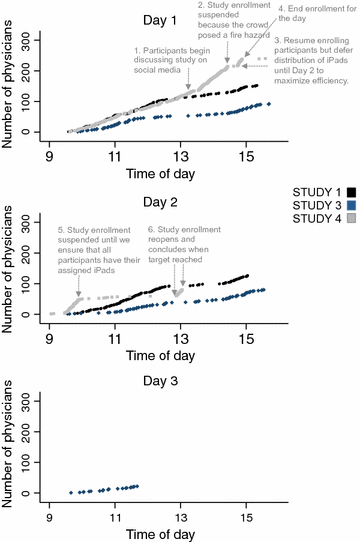Using incentives to recruit physicians into behavioral trials: lessons learned from four studies
- PMID: 29282154
- PMCID: PMC5745997
- DOI: 10.1186/s13104-017-3101-z
Using incentives to recruit physicians into behavioral trials: lessons learned from four studies
Abstract
Objective: To describe lessons learned from the use of different strategies for recruiting physicians responsible for trauma triage, we summarize recruitment data from four behavioral trials run in the United States between 2010 and 2016.
Results: We ran a series of behavioral trials with the primary objective of understanding the influence of heuristics on physician decision making in trauma triage. Three studies were observational; one tested an intervention. The trials used different methods of recruitment (in-person vs. email), timing of the honorarium (pre-paid vs. conditional on completion), type of honorarium [a $100 gift card (monetary reward) vs. an iPad mini 2 (material incentive)], and study tasks (a vignette-based questionnaire, virtual simulation, and intervention plus virtual simulation). We recruited 989 physicians, asking each to complete a questionnaire or virtual simulation online. Recruitment and response rates were 80% in the study where we approached physicians in person, used a pre-paid material incentive, and required that they complete both an intervention plus a virtual simulation. They were 56% when we recruited physicians via email, used a monetary incentive conditional on completion of the task, and required that they complete a vignette-based questionnaire. Trial registration clinicaltrials.gov; NCT02857348.
Keywords: Behavioral trials; Guidelines; Heuristics; Physician adherence; Physicians; Questionnaires; Recruitment; Response rates; Trauma; Video games.
Figures
References
-
- Institute of Medicine . Crossing the quality chasm. Washington D.C.: National Academy of Sciences; 2001.
Publication types
MeSH terms
Associated data
Grants and funding
LinkOut - more resources
Full Text Sources
Other Literature Sources
Medical
Miscellaneous


